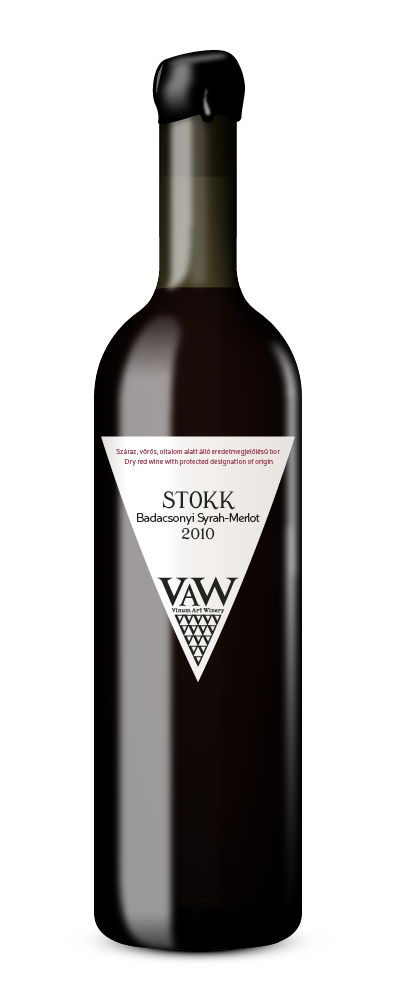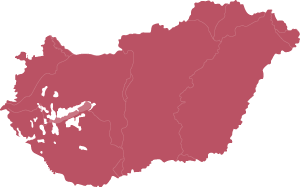Personal opinion:
Unadulterated harmony as in a good marriage; it is excellent also this year. The 50-50 percent mix of Syrah and Merlot. The exciting spiciness of Syrah is made complex by the depth and silkiness of Merlot. Matured in two-year-old, second-filled wooden barrel. An exciting, unisex wine.
Gastronomical pairing:
It is a companion of red meat - I can imagine it with either one. I made mustard pork chop roasted in one and larded with garlic to accompany it. It is worth trying.
About the Merlot variety:
The Merlot is a wine grape variety of French origin, presumably a natural mutation of the Biturica variety. The first complete description of the variety was done by a Bordeaux wine official in 1784. In Hungary they started growing it from the 1960's and by today it can be considered the country's sixth most widespread red wine grape. The bigger plantations can be found in the Szekszárd, Eger, Villány, Tolna and Balaton wine regions. It owes its development into a general world variety to the fact that it yields relatively easily made a good, reliable quality wine with fruity flavour and soft acids.
We can only expect a fruitful, abundant yield in a protected, frost-free location and in a nutrient-rich soil. It shoots early so it is especially sensitive to spring frosts. Its sugar-producing ability is excellent. It ripens late September,early October.
About the Syrah variety:
The Syrah was previously believed to be of Persian origin but today it can be safely stated based on DNA-tests that this variety developed in France. It is a variety that is known in Hungary but is not grown in great quantities. It has a relatively abundant yield. I contains a large quantity of valonia so it is apt for oak barrel maturation but only the best quality should be placed in a new barrique barrel. It gives a full-bodied, fine, excellent wine. Similar to the Cabarnet varieties, it can be matured well. However, it becomes gentle and drinkable earlier. In Hungary they started planting it at the end of 1990's. Today it can also be enjoyed in Hungary, although not in large quantities.
The region and its history:
In the area vine was grown already in Roman times. Emperor Probus had big plantings here. At the time of the settlement of the Magyars in Hungary they already know vine and wine. They appreciated areas capable of growing vine. A significant part of the wine region was taken over by the church in the 13th century. In the 18th-19th century the Badacsony vermouth gained similar reputation to that of the Tokaj aszú in Europe.
During the reconstruction after the phylloxera epidemic supporting walls were built to prevent soil erosion. New varieties also entered the area. The Pinot gris was introduced from France by monks. Due to the special soil content it evolved into a typical local variety, the Szürkebarát which botrytises in good years.
The variety grown in the biggest amount is Italian Riesling that is in better years ripened on the stock longer, and is used to make ice wine or late-harvest hand-selected Italian Riesling. Pinot Gris, Tramini, Muscat Ottonel, Rhine Riesling and Chardonnay are also present on larger lands.
Kéknyelű or "Blue stalk" used to be a characteristic wine of the region. It was significantly confined by the frost damages of the 1980's but is experiencing a revival today, and will be an emblematic wine of the Badacsony region again in the near future.
Badacsony wines are typically full-bodied, fiery, aromatic and mineralized. Traditional wine-making and maturation in wooden barrels are characteristic. Although reductive winemaking and other modern technologies are also spreading, they have not changed the character of the region's wine significantly yet.
Climate and geography:
Badacsony is the highest mountain in the Tapolca Basin; it stands between two bays of Lake Balaton. The circumference of the almost round mountain is 11km, the diametre of its top region slightly elongated in the north-south direction is 1-1.5km, its highest point is 437.4 metres above sea level. Its hillside is covered up to 280 metres by various loose deposits that are excellent for growing vine, and its soil is basalt-based loess. It is covered by various loose deposit, Pannon clay and Pannon loess, above which there are basalt rocks.
Its climate is mild and balanced with high humidity. Because of the proximity of Lake Balaton the southern hills can also enjoy the sunshine reflected from the surface of the water, therefore there is a very beneficial microclimate that makes the making of natural dessert wine possible.
The wine region includes the vine cadastre-based first and second class border sections of the following settlements: Ábrahámhegy, Badacsonytomaj, Badacsonytördemic, Balatonrendes, Balatonszepezd, Diszel, Gyulakeszi, Hegymagas, Káptalantóti, Kisapáti, Kővágóörs, Nemesgulács, Raposka, Révfülöp, Salföld, Szigliget, Tapolca.
NAME: STOKK
YEAR: 2010
VARIETY: Syrah-Merlot
WINE REGION: Badacsony
CLASS: Dry red wine with protected designation of origin
Product of Hungary
Bottle volume: 750ml
Alc.13%vol
Contains sulfites


